Business Research: Stages, Strategies, and Sampling Techniques
VerifiedAdded on 2020/05/16
|14
|4663
|290
Homework Assignment
AI Summary
This assignment solution delves into the core concepts of business research, exploring the seven stages of the research process, including problem identification, literature review, research design, sampling, data collection, data analysis, and report writing. It examines three key strategies in quantitative research, addressing issues like sampling, questionnaire design, and reliability. The document also outlines the purposes of a literature review, emphasizing its role in establishing a theoretical framework and identifying research gaps. Furthermore, it discusses three non-probability sampling techniques: purposive, convenience, and quota sampling. The solution also addresses the importance of questionnaire testing, data analysis techniques, and objectives of report writing, including different types of reports.
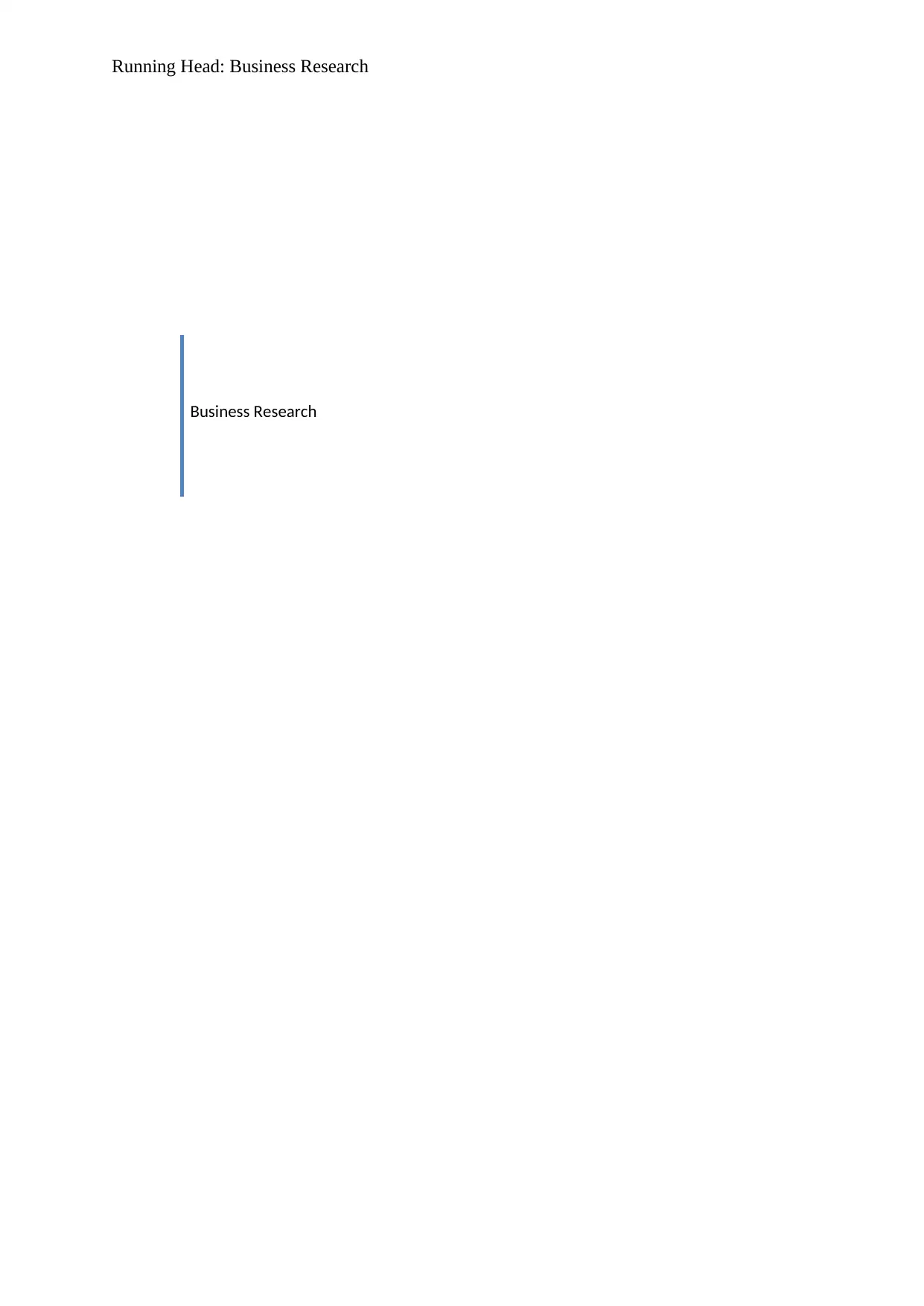
Running Head: Business Research
Business Research
Business Research
Paraphrase This Document
Need a fresh take? Get an instant paraphrase of this document with our AI Paraphraser
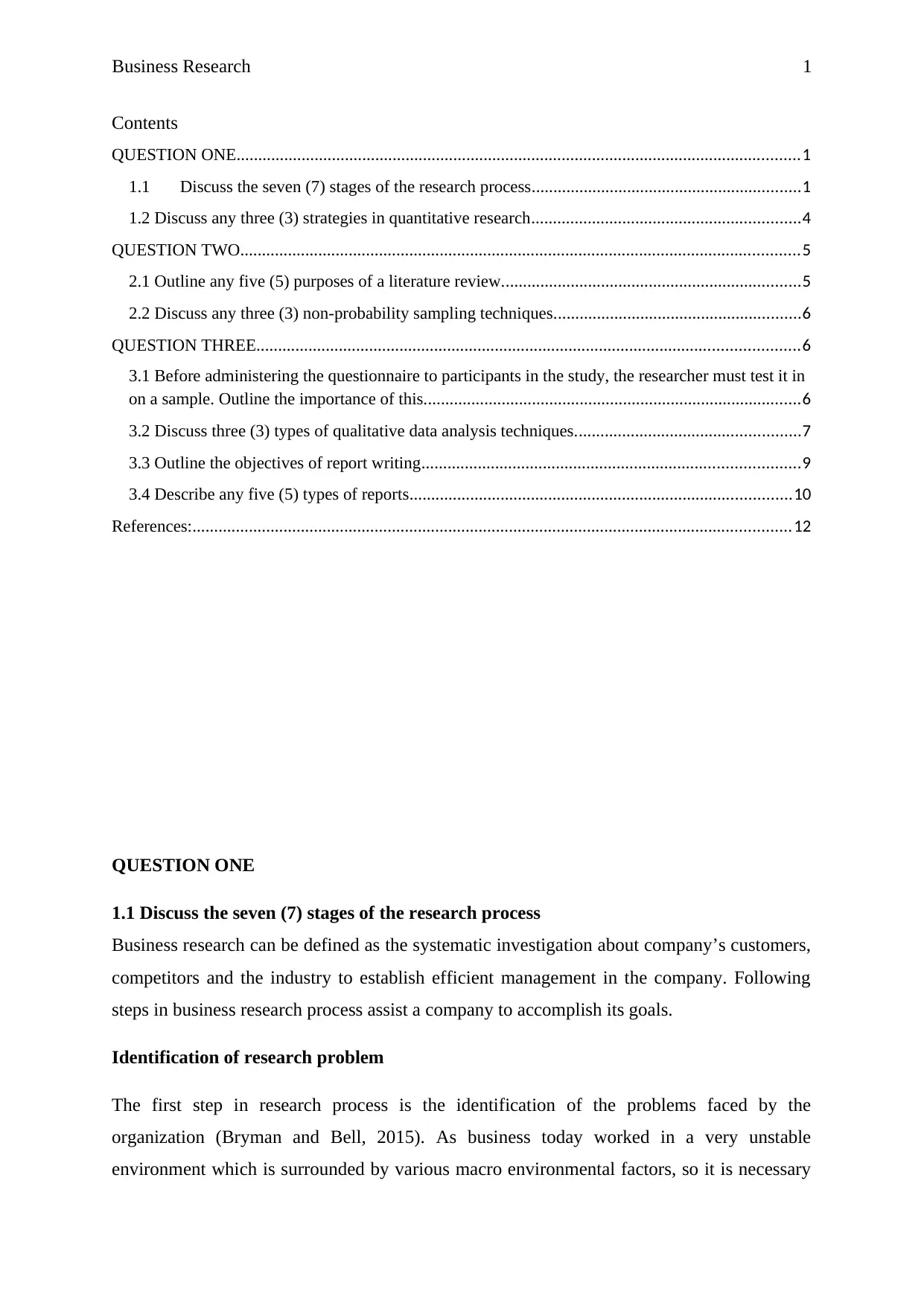
Business Research 1
Contents
QUESTION ONE..................................................................................................................................1
1.1 Discuss the seven (7) stages of the research process..............................................................1
1.2 Discuss any three (3) strategies in quantitative research..............................................................4
QUESTION TWO.................................................................................................................................5
2.1 Outline any five (5) purposes of a literature review.....................................................................5
2.2 Discuss any three (3) non-probability sampling techniques.........................................................6
QUESTION THREE.............................................................................................................................6
3.1 Before administering the questionnaire to participants in the study, the researcher must test it in
on a sample. Outline the importance of this.......................................................................................6
3.2 Discuss three (3) types of qualitative data analysis techniques....................................................7
3.3 Outline the objectives of report writing.......................................................................................9
3.4 Describe any five (5) types of reports........................................................................................10
References:..........................................................................................................................................12
QUESTION ONE
1.1 Discuss the seven (7) stages of the research process
Business research can be defined as the systematic investigation about company’s customers,
competitors and the industry to establish efficient management in the company. Following
steps in business research process assist a company to accomplish its goals.
Identification of research problem
The first step in research process is the identification of the problems faced by the
organization (Bryman and Bell, 2015). As business today worked in a very unstable
environment which is surrounded by various macro environmental factors, so it is necessary
Contents
QUESTION ONE..................................................................................................................................1
1.1 Discuss the seven (7) stages of the research process..............................................................1
1.2 Discuss any three (3) strategies in quantitative research..............................................................4
QUESTION TWO.................................................................................................................................5
2.1 Outline any five (5) purposes of a literature review.....................................................................5
2.2 Discuss any three (3) non-probability sampling techniques.........................................................6
QUESTION THREE.............................................................................................................................6
3.1 Before administering the questionnaire to participants in the study, the researcher must test it in
on a sample. Outline the importance of this.......................................................................................6
3.2 Discuss three (3) types of qualitative data analysis techniques....................................................7
3.3 Outline the objectives of report writing.......................................................................................9
3.4 Describe any five (5) types of reports........................................................................................10
References:..........................................................................................................................................12
QUESTION ONE
1.1 Discuss the seven (7) stages of the research process
Business research can be defined as the systematic investigation about company’s customers,
competitors and the industry to establish efficient management in the company. Following
steps in business research process assist a company to accomplish its goals.
Identification of research problem
The first step in research process is the identification of the problems faced by the
organization (Bryman and Bell, 2015). As business today worked in a very unstable
environment which is surrounded by various macro environmental factors, so it is necessary
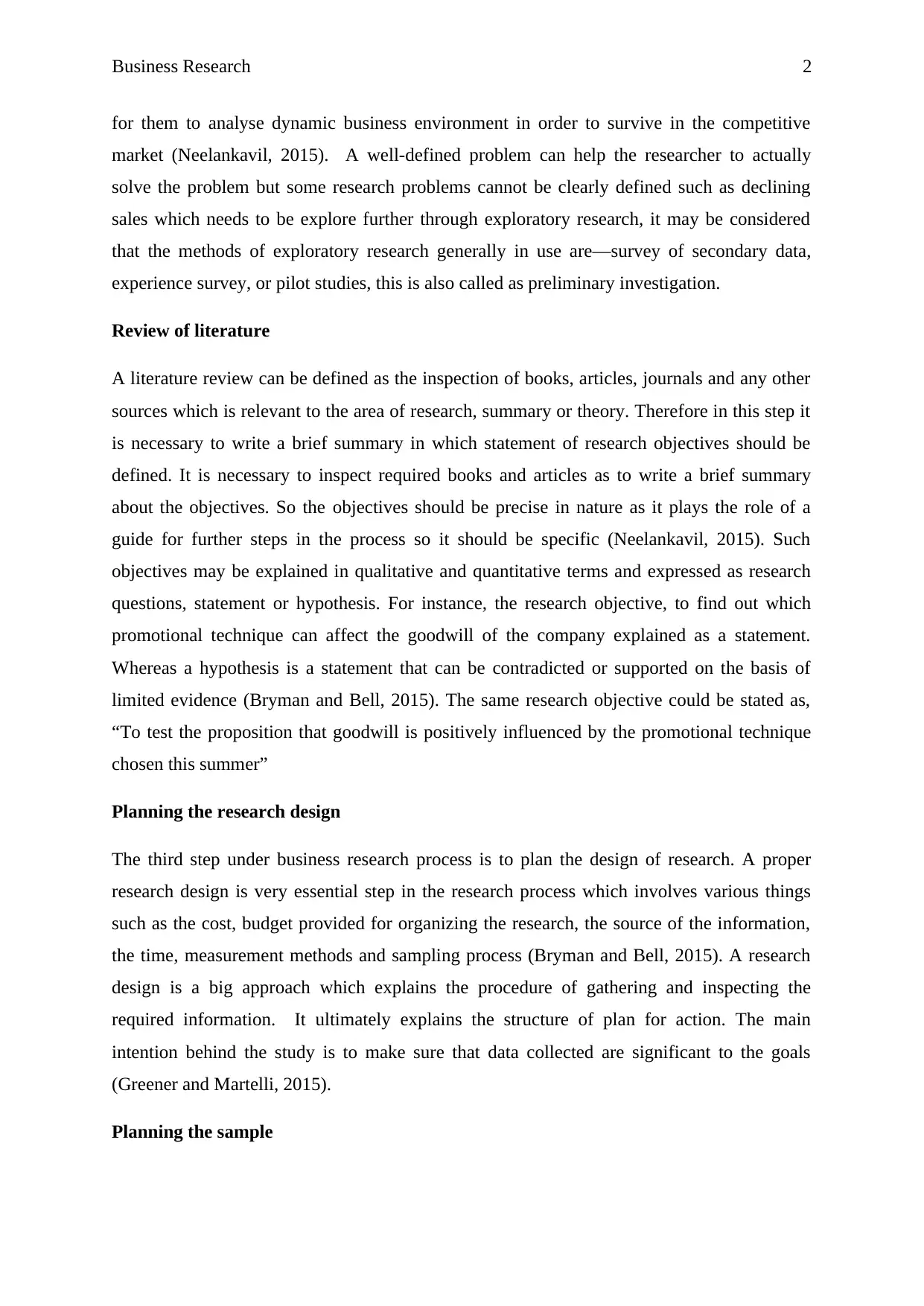
Business Research 2
for them to analyse dynamic business environment in order to survive in the competitive
market (Neelankavil, 2015). A well-defined problem can help the researcher to actually
solve the problem but some research problems cannot be clearly defined such as declining
sales which needs to be explore further through exploratory research, it may be considered
that the methods of exploratory research generally in use are—survey of secondary data,
experience survey, or pilot studies, this is also called as preliminary investigation.
Review of literature
A literature review can be defined as the inspection of books, articles, journals and any other
sources which is relevant to the area of research, summary or theory. Therefore in this step it
is necessary to write a brief summary in which statement of research objectives should be
defined. It is necessary to inspect required books and articles as to write a brief summary
about the objectives. So the objectives should be precise in nature as it plays the role of a
guide for further steps in the process so it should be specific (Neelankavil, 2015). Such
objectives may be explained in qualitative and quantitative terms and expressed as research
questions, statement or hypothesis. For instance, the research objective, to find out which
promotional technique can affect the goodwill of the company explained as a statement.
Whereas a hypothesis is a statement that can be contradicted or supported on the basis of
limited evidence (Bryman and Bell, 2015). The same research objective could be stated as,
“To test the proposition that goodwill is positively influenced by the promotional technique
chosen this summer”
Planning the research design
The third step under business research process is to plan the design of research. A proper
research design is very essential step in the research process which involves various things
such as the cost, budget provided for organizing the research, the source of the information,
the time, measurement methods and sampling process (Bryman and Bell, 2015). A research
design is a big approach which explains the procedure of gathering and inspecting the
required information. It ultimately explains the structure of plan for action. The main
intention behind the study is to make sure that data collected are significant to the goals
(Greener and Martelli, 2015).
Planning the sample
for them to analyse dynamic business environment in order to survive in the competitive
market (Neelankavil, 2015). A well-defined problem can help the researcher to actually
solve the problem but some research problems cannot be clearly defined such as declining
sales which needs to be explore further through exploratory research, it may be considered
that the methods of exploratory research generally in use are—survey of secondary data,
experience survey, or pilot studies, this is also called as preliminary investigation.
Review of literature
A literature review can be defined as the inspection of books, articles, journals and any other
sources which is relevant to the area of research, summary or theory. Therefore in this step it
is necessary to write a brief summary in which statement of research objectives should be
defined. It is necessary to inspect required books and articles as to write a brief summary
about the objectives. So the objectives should be precise in nature as it plays the role of a
guide for further steps in the process so it should be specific (Neelankavil, 2015). Such
objectives may be explained in qualitative and quantitative terms and expressed as research
questions, statement or hypothesis. For instance, the research objective, to find out which
promotional technique can affect the goodwill of the company explained as a statement.
Whereas a hypothesis is a statement that can be contradicted or supported on the basis of
limited evidence (Bryman and Bell, 2015). The same research objective could be stated as,
“To test the proposition that goodwill is positively influenced by the promotional technique
chosen this summer”
Planning the research design
The third step under business research process is to plan the design of research. A proper
research design is very essential step in the research process which involves various things
such as the cost, budget provided for organizing the research, the source of the information,
the time, measurement methods and sampling process (Bryman and Bell, 2015). A research
design is a big approach which explains the procedure of gathering and inspecting the
required information. It ultimately explains the structure of plan for action. The main
intention behind the study is to make sure that data collected are significant to the goals
(Greener and Martelli, 2015).
Planning the sample
⊘ This is a preview!⊘
Do you want full access?
Subscribe today to unlock all pages.

Trusted by 1+ million students worldwide
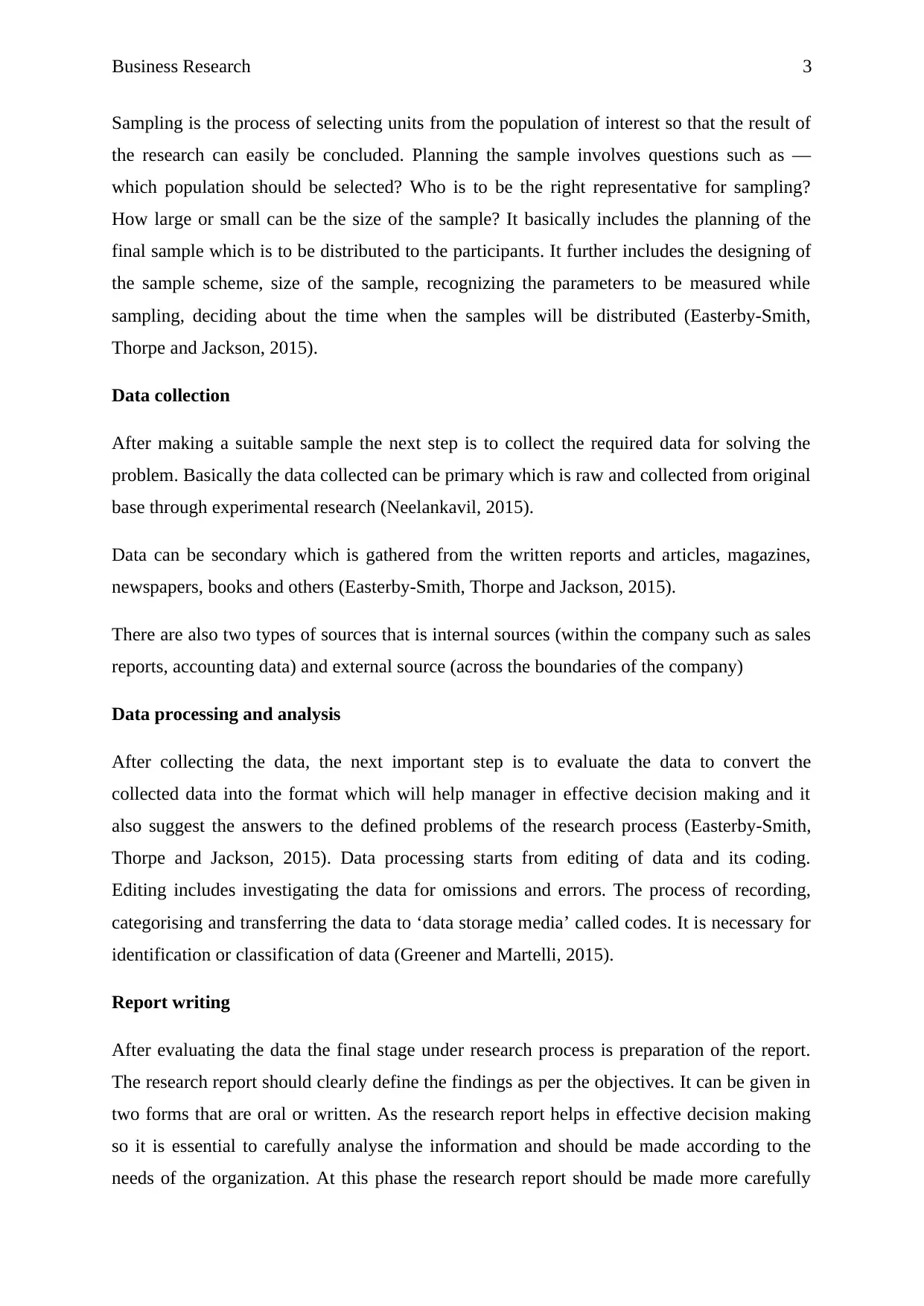
Business Research 3
Sampling is the process of selecting units from the population of interest so that the result of
the research can easily be concluded. Planning the sample involves questions such as —
which population should be selected? Who is to be the right representative for sampling?
How large or small can be the size of the sample? It basically includes the planning of the
final sample which is to be distributed to the participants. It further includes the designing of
the sample scheme, size of the sample, recognizing the parameters to be measured while
sampling, deciding about the time when the samples will be distributed (Easterby-Smith,
Thorpe and Jackson, 2015).
Data collection
After making a suitable sample the next step is to collect the required data for solving the
problem. Basically the data collected can be primary which is raw and collected from original
base through experimental research (Neelankavil, 2015).
Data can be secondary which is gathered from the written reports and articles, magazines,
newspapers, books and others (Easterby-Smith, Thorpe and Jackson, 2015).
There are also two types of sources that is internal sources (within the company such as sales
reports, accounting data) and external source (across the boundaries of the company)
Data processing and analysis
After collecting the data, the next important step is to evaluate the data to convert the
collected data into the format which will help manager in effective decision making and it
also suggest the answers to the defined problems of the research process (Easterby-Smith,
Thorpe and Jackson, 2015). Data processing starts from editing of data and its coding.
Editing includes investigating the data for omissions and errors. The process of recording,
categorising and transferring the data to ‘data storage media’ called codes. It is necessary for
identification or classification of data (Greener and Martelli, 2015).
Report writing
After evaluating the data the final stage under research process is preparation of the report.
The research report should clearly define the findings as per the objectives. It can be given in
two forms that are oral or written. As the research report helps in effective decision making
so it is essential to carefully analyse the information and should be made according to the
needs of the organization. At this phase the research report should be made more carefully
Sampling is the process of selecting units from the population of interest so that the result of
the research can easily be concluded. Planning the sample involves questions such as —
which population should be selected? Who is to be the right representative for sampling?
How large or small can be the size of the sample? It basically includes the planning of the
final sample which is to be distributed to the participants. It further includes the designing of
the sample scheme, size of the sample, recognizing the parameters to be measured while
sampling, deciding about the time when the samples will be distributed (Easterby-Smith,
Thorpe and Jackson, 2015).
Data collection
After making a suitable sample the next step is to collect the required data for solving the
problem. Basically the data collected can be primary which is raw and collected from original
base through experimental research (Neelankavil, 2015).
Data can be secondary which is gathered from the written reports and articles, magazines,
newspapers, books and others (Easterby-Smith, Thorpe and Jackson, 2015).
There are also two types of sources that is internal sources (within the company such as sales
reports, accounting data) and external source (across the boundaries of the company)
Data processing and analysis
After collecting the data, the next important step is to evaluate the data to convert the
collected data into the format which will help manager in effective decision making and it
also suggest the answers to the defined problems of the research process (Easterby-Smith,
Thorpe and Jackson, 2015). Data processing starts from editing of data and its coding.
Editing includes investigating the data for omissions and errors. The process of recording,
categorising and transferring the data to ‘data storage media’ called codes. It is necessary for
identification or classification of data (Greener and Martelli, 2015).
Report writing
After evaluating the data the final stage under research process is preparation of the report.
The research report should clearly define the findings as per the objectives. It can be given in
two forms that are oral or written. As the research report helps in effective decision making
so it is essential to carefully analyse the information and should be made according to the
needs of the organization. At this phase the research report should be made more carefully
Paraphrase This Document
Need a fresh take? Get an instant paraphrase of this document with our AI Paraphraser
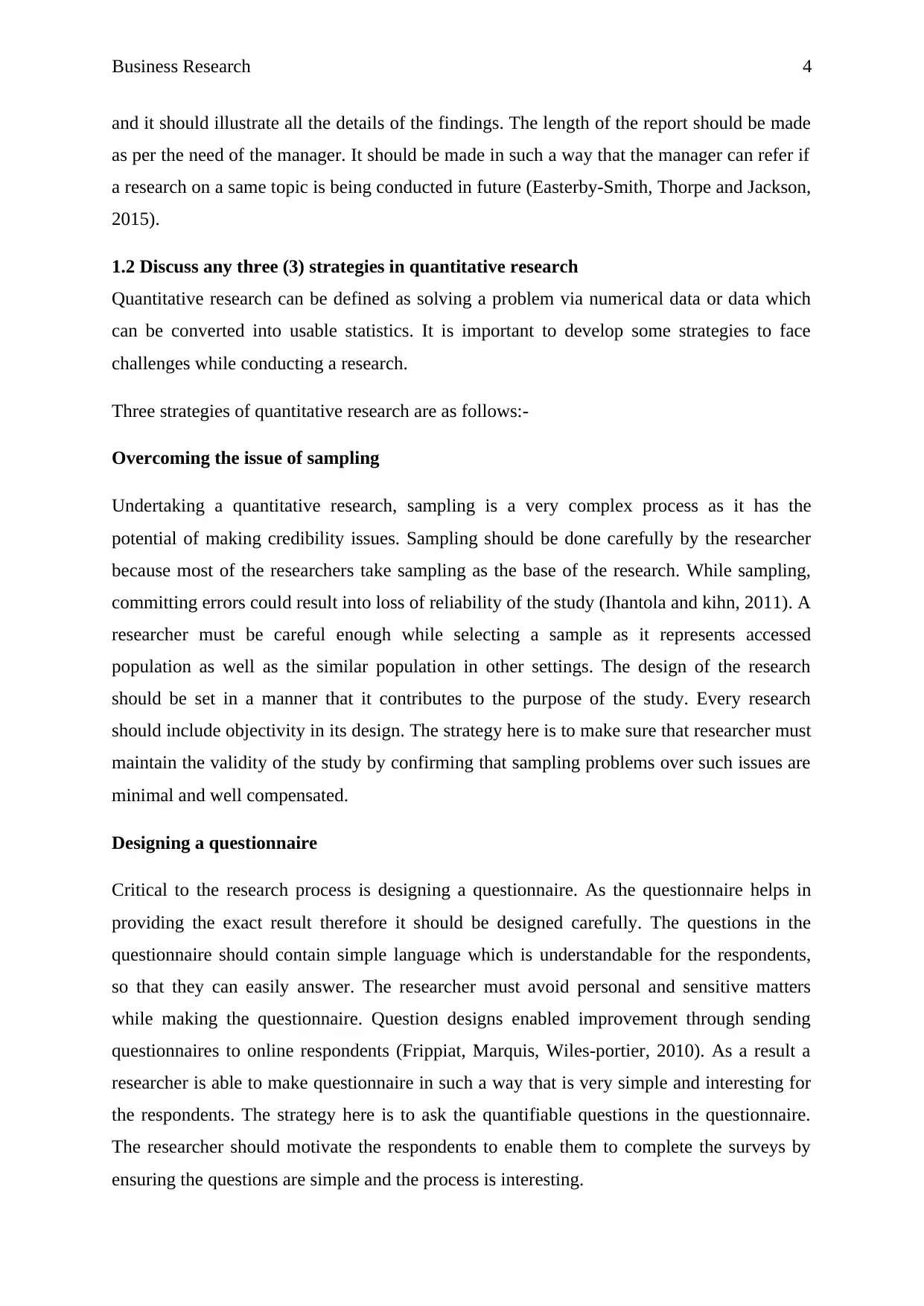
Business Research 4
and it should illustrate all the details of the findings. The length of the report should be made
as per the need of the manager. It should be made in such a way that the manager can refer if
a research on a same topic is being conducted in future (Easterby-Smith, Thorpe and Jackson,
2015).
1.2 Discuss any three (3) strategies in quantitative research
Quantitative research can be defined as solving a problem via numerical data or data which
can be converted into usable statistics. It is important to develop some strategies to face
challenges while conducting a research.
Three strategies of quantitative research are as follows:-
Overcoming the issue of sampling
Undertaking a quantitative research, sampling is a very complex process as it has the
potential of making credibility issues. Sampling should be done carefully by the researcher
because most of the researchers take sampling as the base of the research. While sampling,
committing errors could result into loss of reliability of the study (Ihantola and kihn, 2011). A
researcher must be careful enough while selecting a sample as it represents accessed
population as well as the similar population in other settings. The design of the research
should be set in a manner that it contributes to the purpose of the study. Every research
should include objectivity in its design. The strategy here is to make sure that researcher must
maintain the validity of the study by confirming that sampling problems over such issues are
minimal and well compensated.
Designing a questionnaire
Critical to the research process is designing a questionnaire. As the questionnaire helps in
providing the exact result therefore it should be designed carefully. The questions in the
questionnaire should contain simple language which is understandable for the respondents,
so that they can easily answer. The researcher must avoid personal and sensitive matters
while making the questionnaire. Question designs enabled improvement through sending
questionnaires to online respondents (Frippiat, Marquis, Wiles-portier, 2010). As a result a
researcher is able to make questionnaire in such a way that is very simple and interesting for
the respondents. The strategy here is to ask the quantifiable questions in the questionnaire.
The researcher should motivate the respondents to enable them to complete the surveys by
ensuring the questions are simple and the process is interesting.
and it should illustrate all the details of the findings. The length of the report should be made
as per the need of the manager. It should be made in such a way that the manager can refer if
a research on a same topic is being conducted in future (Easterby-Smith, Thorpe and Jackson,
2015).
1.2 Discuss any three (3) strategies in quantitative research
Quantitative research can be defined as solving a problem via numerical data or data which
can be converted into usable statistics. It is important to develop some strategies to face
challenges while conducting a research.
Three strategies of quantitative research are as follows:-
Overcoming the issue of sampling
Undertaking a quantitative research, sampling is a very complex process as it has the
potential of making credibility issues. Sampling should be done carefully by the researcher
because most of the researchers take sampling as the base of the research. While sampling,
committing errors could result into loss of reliability of the study (Ihantola and kihn, 2011). A
researcher must be careful enough while selecting a sample as it represents accessed
population as well as the similar population in other settings. The design of the research
should be set in a manner that it contributes to the purpose of the study. Every research
should include objectivity in its design. The strategy here is to make sure that researcher must
maintain the validity of the study by confirming that sampling problems over such issues are
minimal and well compensated.
Designing a questionnaire
Critical to the research process is designing a questionnaire. As the questionnaire helps in
providing the exact result therefore it should be designed carefully. The questions in the
questionnaire should contain simple language which is understandable for the respondents,
so that they can easily answer. The researcher must avoid personal and sensitive matters
while making the questionnaire. Question designs enabled improvement through sending
questionnaires to online respondents (Frippiat, Marquis, Wiles-portier, 2010). As a result a
researcher is able to make questionnaire in such a way that is very simple and interesting for
the respondents. The strategy here is to ask the quantifiable questions in the questionnaire.
The researcher should motivate the respondents to enable them to complete the surveys by
ensuring the questions are simple and the process is interesting.
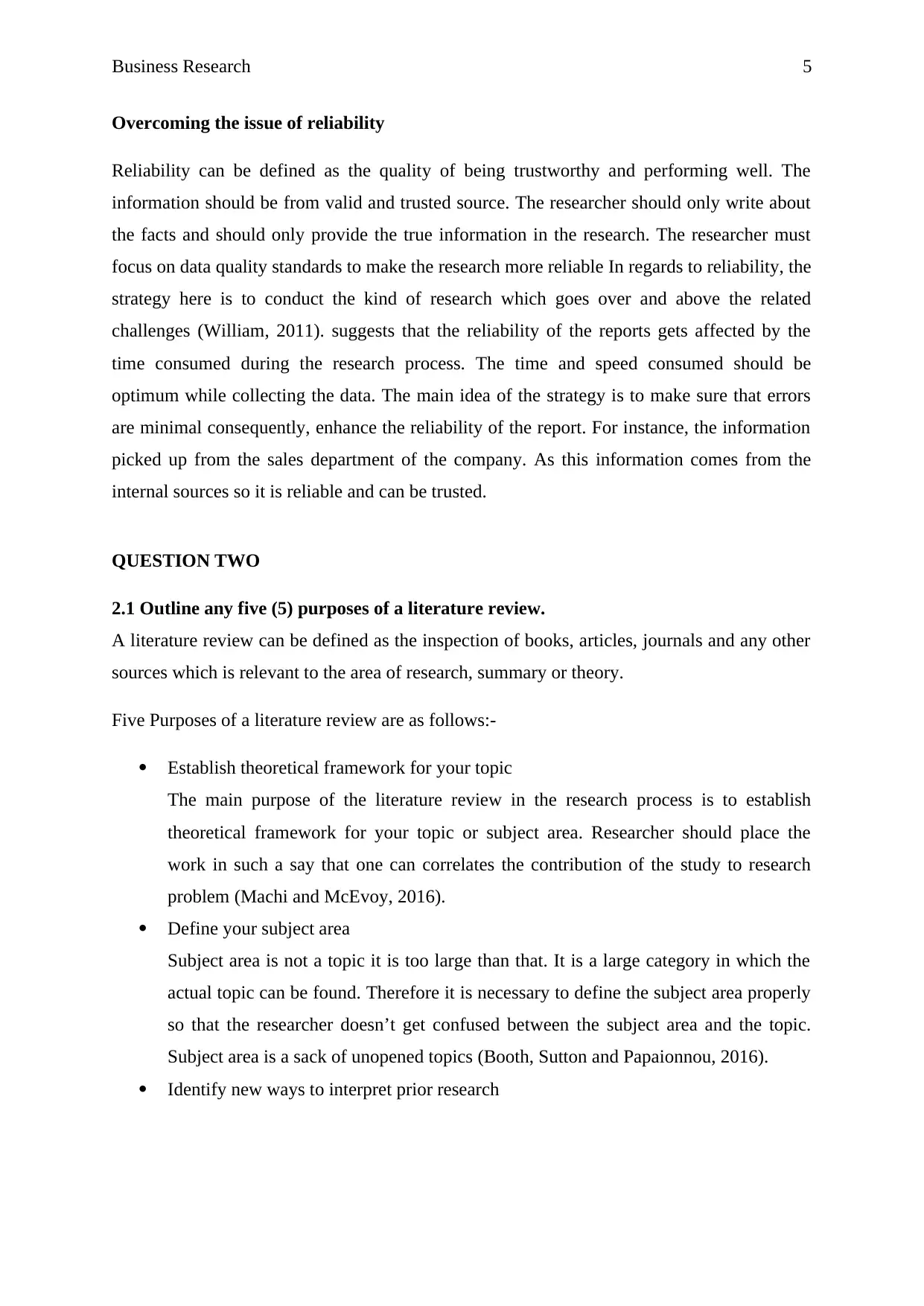
Business Research 5
Overcoming the issue of reliability
Reliability can be defined as the quality of being trustworthy and performing well. The
information should be from valid and trusted source. The researcher should only write about
the facts and should only provide the true information in the research. The researcher must
focus on data quality standards to make the research more reliable In regards to reliability, the
strategy here is to conduct the kind of research which goes over and above the related
challenges (William, 2011). suggests that the reliability of the reports gets affected by the
time consumed during the research process. The time and speed consumed should be
optimum while collecting the data. The main idea of the strategy is to make sure that errors
are minimal consequently, enhance the reliability of the report. For instance, the information
picked up from the sales department of the company. As this information comes from the
internal sources so it is reliable and can be trusted.
QUESTION TWO
2.1 Outline any five (5) purposes of a literature review.
A literature review can be defined as the inspection of books, articles, journals and any other
sources which is relevant to the area of research, summary or theory.
Five Purposes of a literature review are as follows:-
Establish theoretical framework for your topic
The main purpose of the literature review in the research process is to establish
theoretical framework for your topic or subject area. Researcher should place the
work in such a say that one can correlates the contribution of the study to research
problem (Machi and McEvoy, 2016).
Define your subject area
Subject area is not a topic it is too large than that. It is a large category in which the
actual topic can be found. Therefore it is necessary to define the subject area properly
so that the researcher doesn’t get confused between the subject area and the topic.
Subject area is a sack of unopened topics (Booth, Sutton and Papaionnou, 2016).
Identify new ways to interpret prior research
Overcoming the issue of reliability
Reliability can be defined as the quality of being trustworthy and performing well. The
information should be from valid and trusted source. The researcher should only write about
the facts and should only provide the true information in the research. The researcher must
focus on data quality standards to make the research more reliable In regards to reliability, the
strategy here is to conduct the kind of research which goes over and above the related
challenges (William, 2011). suggests that the reliability of the reports gets affected by the
time consumed during the research process. The time and speed consumed should be
optimum while collecting the data. The main idea of the strategy is to make sure that errors
are minimal consequently, enhance the reliability of the report. For instance, the information
picked up from the sales department of the company. As this information comes from the
internal sources so it is reliable and can be trusted.
QUESTION TWO
2.1 Outline any five (5) purposes of a literature review.
A literature review can be defined as the inspection of books, articles, journals and any other
sources which is relevant to the area of research, summary or theory.
Five Purposes of a literature review are as follows:-
Establish theoretical framework for your topic
The main purpose of the literature review in the research process is to establish
theoretical framework for your topic or subject area. Researcher should place the
work in such a say that one can correlates the contribution of the study to research
problem (Machi and McEvoy, 2016).
Define your subject area
Subject area is not a topic it is too large than that. It is a large category in which the
actual topic can be found. Therefore it is necessary to define the subject area properly
so that the researcher doesn’t get confused between the subject area and the topic.
Subject area is a sack of unopened topics (Booth, Sutton and Papaionnou, 2016).
Identify new ways to interpret prior research
⊘ This is a preview!⊘
Do you want full access?
Subscribe today to unlock all pages.

Trusted by 1+ million students worldwide
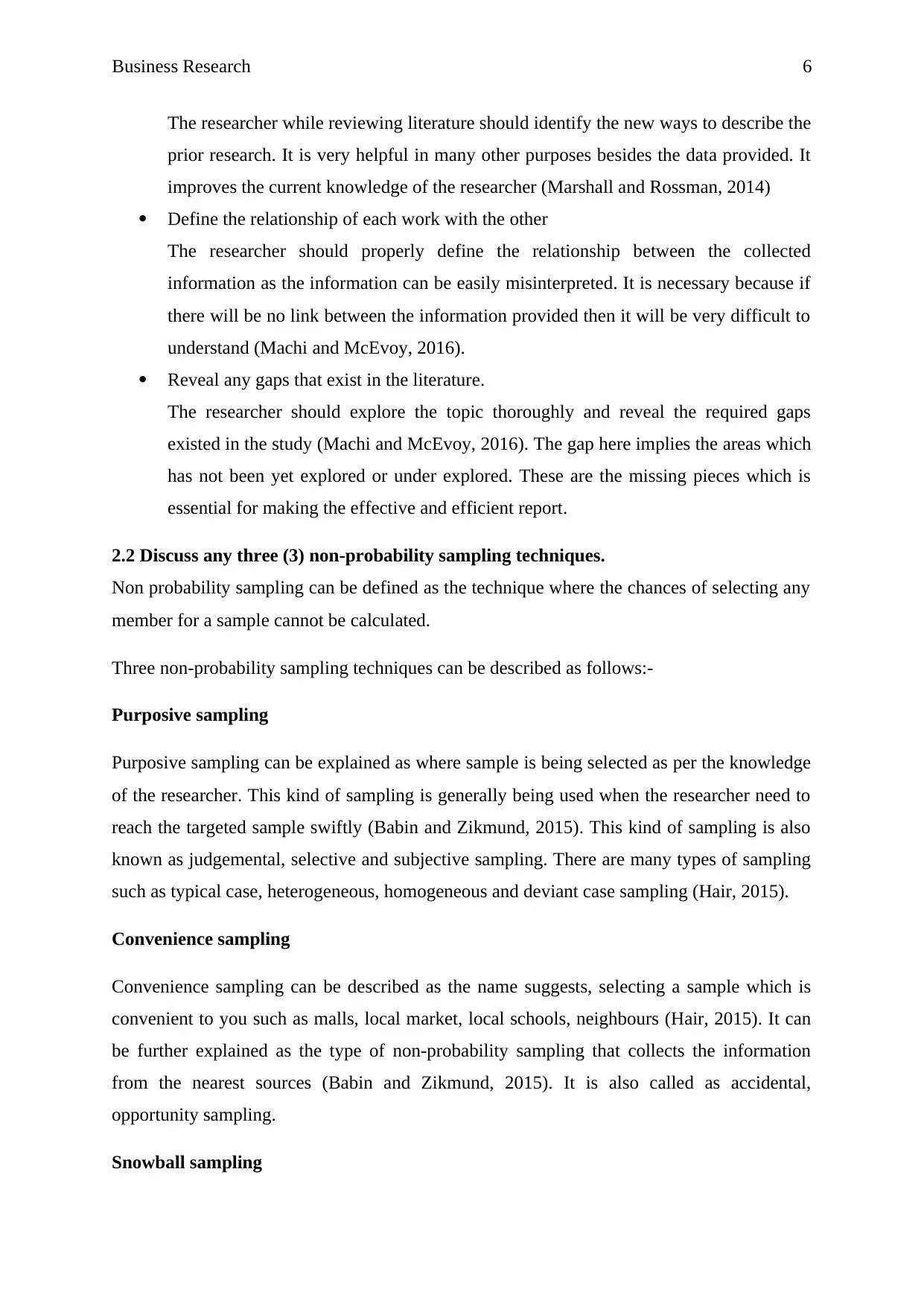
Business Research 6
The researcher while reviewing literature should identify the new ways to describe the
prior research. It is very helpful in many other purposes besides the data provided. It
improves the current knowledge of the researcher (Marshall and Rossman, 2014)
Define the relationship of each work with the other
The researcher should properly define the relationship between the collected
information as the information can be easily misinterpreted. It is necessary because if
there will be no link between the information provided then it will be very difficult to
understand (Machi and McEvoy, 2016).
Reveal any gaps that exist in the literature.
The researcher should explore the topic thoroughly and reveal the required gaps
existed in the study (Machi and McEvoy, 2016). The gap here implies the areas which
has not been yet explored or under explored. These are the missing pieces which is
essential for making the effective and efficient report.
2.2 Discuss any three (3) non-probability sampling techniques.
Non probability sampling can be defined as the technique where the chances of selecting any
member for a sample cannot be calculated.
Three non-probability sampling techniques can be described as follows:-
Purposive sampling
Purposive sampling can be explained as where sample is being selected as per the knowledge
of the researcher. This kind of sampling is generally being used when the researcher need to
reach the targeted sample swiftly (Babin and Zikmund, 2015). This kind of sampling is also
known as judgemental, selective and subjective sampling. There are many types of sampling
such as typical case, heterogeneous, homogeneous and deviant case sampling (Hair, 2015).
Convenience sampling
Convenience sampling can be described as the name suggests, selecting a sample which is
convenient to you such as malls, local market, local schools, neighbours (Hair, 2015). It can
be further explained as the type of non-probability sampling that collects the information
from the nearest sources (Babin and Zikmund, 2015). It is also called as accidental,
opportunity sampling.
Snowball sampling
The researcher while reviewing literature should identify the new ways to describe the
prior research. It is very helpful in many other purposes besides the data provided. It
improves the current knowledge of the researcher (Marshall and Rossman, 2014)
Define the relationship of each work with the other
The researcher should properly define the relationship between the collected
information as the information can be easily misinterpreted. It is necessary because if
there will be no link between the information provided then it will be very difficult to
understand (Machi and McEvoy, 2016).
Reveal any gaps that exist in the literature.
The researcher should explore the topic thoroughly and reveal the required gaps
existed in the study (Machi and McEvoy, 2016). The gap here implies the areas which
has not been yet explored or under explored. These are the missing pieces which is
essential for making the effective and efficient report.
2.2 Discuss any three (3) non-probability sampling techniques.
Non probability sampling can be defined as the technique where the chances of selecting any
member for a sample cannot be calculated.
Three non-probability sampling techniques can be described as follows:-
Purposive sampling
Purposive sampling can be explained as where sample is being selected as per the knowledge
of the researcher. This kind of sampling is generally being used when the researcher need to
reach the targeted sample swiftly (Babin and Zikmund, 2015). This kind of sampling is also
known as judgemental, selective and subjective sampling. There are many types of sampling
such as typical case, heterogeneous, homogeneous and deviant case sampling (Hair, 2015).
Convenience sampling
Convenience sampling can be described as the name suggests, selecting a sample which is
convenient to you such as malls, local market, local schools, neighbours (Hair, 2015). It can
be further explained as the type of non-probability sampling that collects the information
from the nearest sources (Babin and Zikmund, 2015). It is also called as accidental,
opportunity sampling.
Snowball sampling
Paraphrase This Document
Need a fresh take? Get an instant paraphrase of this document with our AI Paraphraser
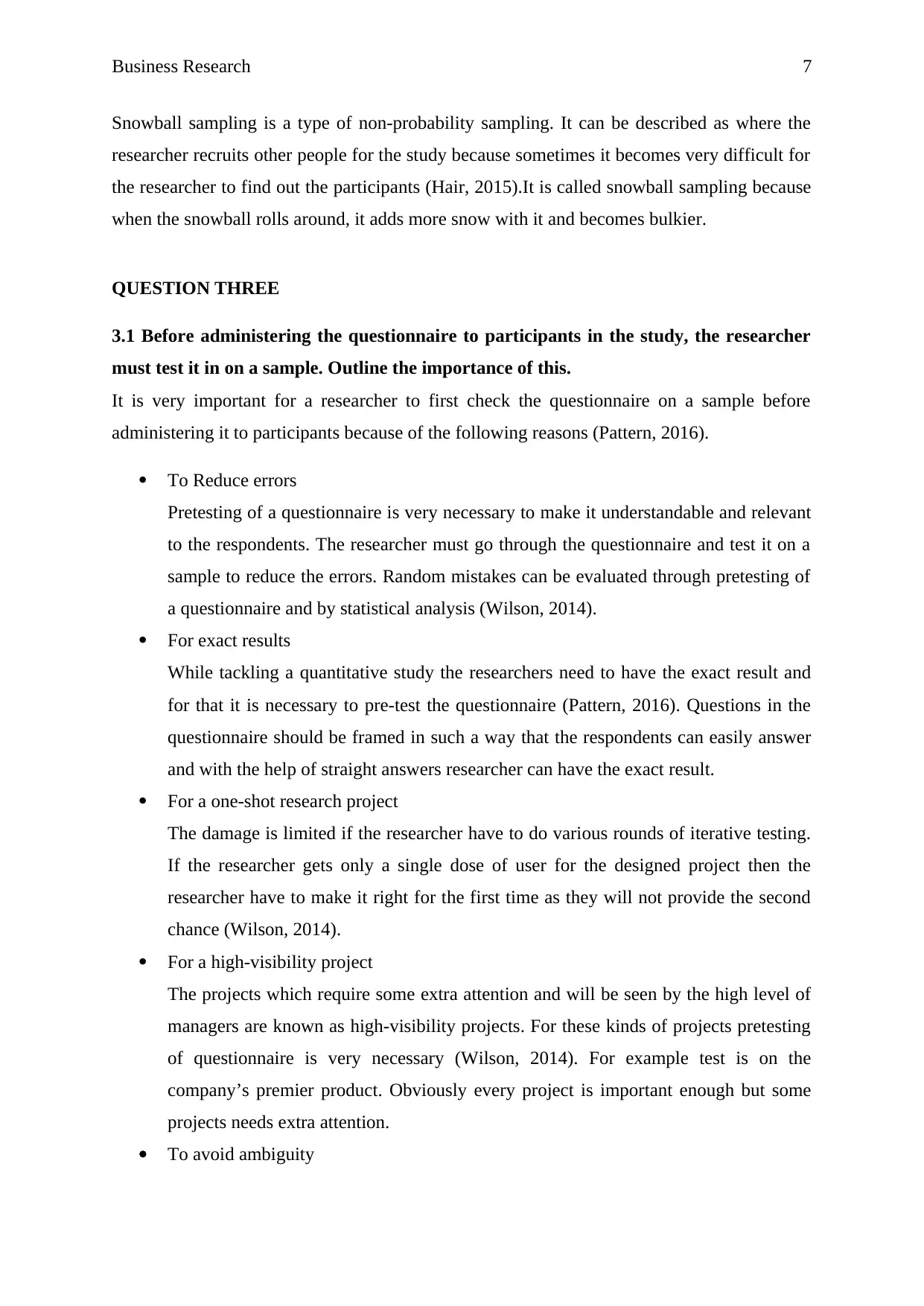
Business Research 7
Snowball sampling is a type of non-probability sampling. It can be described as where the
researcher recruits other people for the study because sometimes it becomes very difficult for
the researcher to find out the participants (Hair, 2015).It is called snowball sampling because
when the snowball rolls around, it adds more snow with it and becomes bulkier.
QUESTION THREE
3.1 Before administering the questionnaire to participants in the study, the researcher
must test it in on a sample. Outline the importance of this.
It is very important for a researcher to first check the questionnaire on a sample before
administering it to participants because of the following reasons (Pattern, 2016).
To Reduce errors
Pretesting of a questionnaire is very necessary to make it understandable and relevant
to the respondents. The researcher must go through the questionnaire and test it on a
sample to reduce the errors. Random mistakes can be evaluated through pretesting of
a questionnaire and by statistical analysis (Wilson, 2014).
For exact results
While tackling a quantitative study the researchers need to have the exact result and
for that it is necessary to pre-test the questionnaire (Pattern, 2016). Questions in the
questionnaire should be framed in such a way that the respondents can easily answer
and with the help of straight answers researcher can have the exact result.
For a one-shot research project
The damage is limited if the researcher have to do various rounds of iterative testing.
If the researcher gets only a single dose of user for the designed project then the
researcher have to make it right for the first time as they will not provide the second
chance (Wilson, 2014).
For a high-visibility project
The projects which require some extra attention and will be seen by the high level of
managers are known as high-visibility projects. For these kinds of projects pretesting
of questionnaire is very necessary (Wilson, 2014). For example test is on the
company’s premier product. Obviously every project is important enough but some
projects needs extra attention.
To avoid ambiguity
Snowball sampling is a type of non-probability sampling. It can be described as where the
researcher recruits other people for the study because sometimes it becomes very difficult for
the researcher to find out the participants (Hair, 2015).It is called snowball sampling because
when the snowball rolls around, it adds more snow with it and becomes bulkier.
QUESTION THREE
3.1 Before administering the questionnaire to participants in the study, the researcher
must test it in on a sample. Outline the importance of this.
It is very important for a researcher to first check the questionnaire on a sample before
administering it to participants because of the following reasons (Pattern, 2016).
To Reduce errors
Pretesting of a questionnaire is very necessary to make it understandable and relevant
to the respondents. The researcher must go through the questionnaire and test it on a
sample to reduce the errors. Random mistakes can be evaluated through pretesting of
a questionnaire and by statistical analysis (Wilson, 2014).
For exact results
While tackling a quantitative study the researchers need to have the exact result and
for that it is necessary to pre-test the questionnaire (Pattern, 2016). Questions in the
questionnaire should be framed in such a way that the respondents can easily answer
and with the help of straight answers researcher can have the exact result.
For a one-shot research project
The damage is limited if the researcher have to do various rounds of iterative testing.
If the researcher gets only a single dose of user for the designed project then the
researcher have to make it right for the first time as they will not provide the second
chance (Wilson, 2014).
For a high-visibility project
The projects which require some extra attention and will be seen by the high level of
managers are known as high-visibility projects. For these kinds of projects pretesting
of questionnaire is very necessary (Wilson, 2014). For example test is on the
company’s premier product. Obviously every project is important enough but some
projects needs extra attention.
To avoid ambiguity
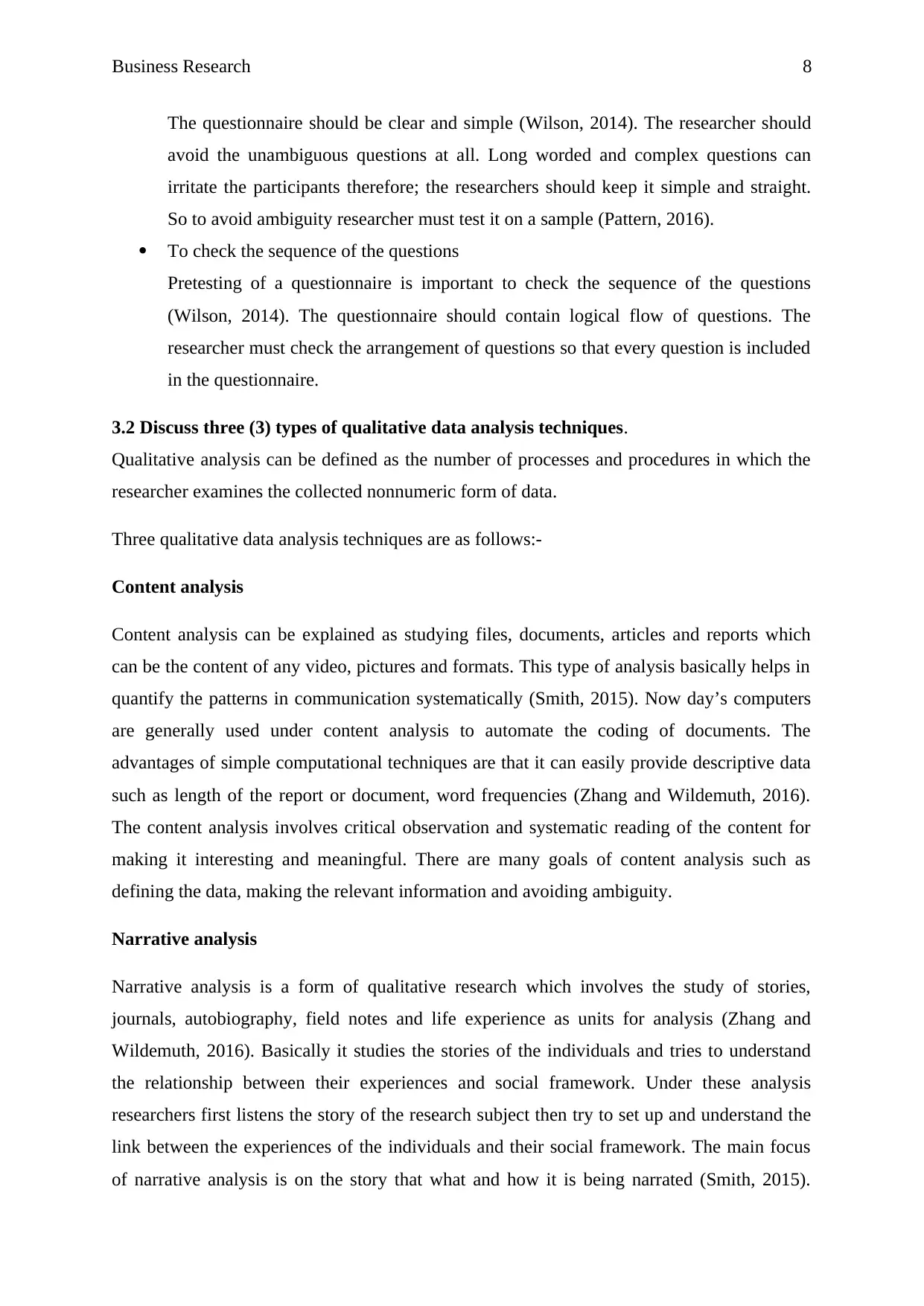
Business Research 8
The questionnaire should be clear and simple (Wilson, 2014). The researcher should
avoid the unambiguous questions at all. Long worded and complex questions can
irritate the participants therefore; the researchers should keep it simple and straight.
So to avoid ambiguity researcher must test it on a sample (Pattern, 2016).
To check the sequence of the questions
Pretesting of a questionnaire is important to check the sequence of the questions
(Wilson, 2014). The questionnaire should contain logical flow of questions. The
researcher must check the arrangement of questions so that every question is included
in the questionnaire.
3.2 Discuss three (3) types of qualitative data analysis techniques.
Qualitative analysis can be defined as the number of processes and procedures in which the
researcher examines the collected nonnumeric form of data.
Three qualitative data analysis techniques are as follows:-
Content analysis
Content analysis can be explained as studying files, documents, articles and reports which
can be the content of any video, pictures and formats. This type of analysis basically helps in
quantify the patterns in communication systematically (Smith, 2015). Now day’s computers
are generally used under content analysis to automate the coding of documents. The
advantages of simple computational techniques are that it can easily provide descriptive data
such as length of the report or document, word frequencies (Zhang and Wildemuth, 2016).
The content analysis involves critical observation and systematic reading of the content for
making it interesting and meaningful. There are many goals of content analysis such as
defining the data, making the relevant information and avoiding ambiguity.
Narrative analysis
Narrative analysis is a form of qualitative research which involves the study of stories,
journals, autobiography, field notes and life experience as units for analysis (Zhang and
Wildemuth, 2016). Basically it studies the stories of the individuals and tries to understand
the relationship between their experiences and social framework. Under these analysis
researchers first listens the story of the research subject then try to set up and understand the
link between the experiences of the individuals and their social framework. The main focus
of narrative analysis is on the story that what and how it is being narrated (Smith, 2015).
The questionnaire should be clear and simple (Wilson, 2014). The researcher should
avoid the unambiguous questions at all. Long worded and complex questions can
irritate the participants therefore; the researchers should keep it simple and straight.
So to avoid ambiguity researcher must test it on a sample (Pattern, 2016).
To check the sequence of the questions
Pretesting of a questionnaire is important to check the sequence of the questions
(Wilson, 2014). The questionnaire should contain logical flow of questions. The
researcher must check the arrangement of questions so that every question is included
in the questionnaire.
3.2 Discuss three (3) types of qualitative data analysis techniques.
Qualitative analysis can be defined as the number of processes and procedures in which the
researcher examines the collected nonnumeric form of data.
Three qualitative data analysis techniques are as follows:-
Content analysis
Content analysis can be explained as studying files, documents, articles and reports which
can be the content of any video, pictures and formats. This type of analysis basically helps in
quantify the patterns in communication systematically (Smith, 2015). Now day’s computers
are generally used under content analysis to automate the coding of documents. The
advantages of simple computational techniques are that it can easily provide descriptive data
such as length of the report or document, word frequencies (Zhang and Wildemuth, 2016).
The content analysis involves critical observation and systematic reading of the content for
making it interesting and meaningful. There are many goals of content analysis such as
defining the data, making the relevant information and avoiding ambiguity.
Narrative analysis
Narrative analysis is a form of qualitative research which involves the study of stories,
journals, autobiography, field notes and life experience as units for analysis (Zhang and
Wildemuth, 2016). Basically it studies the stories of the individuals and tries to understand
the relationship between their experiences and social framework. Under these analysis
researchers first listens the story of the research subject then try to set up and understand the
link between the experiences of the individuals and their social framework. The main focus
of narrative analysis is on the story that what and how it is being narrated (Smith, 2015).
⊘ This is a preview!⊘
Do you want full access?
Subscribe today to unlock all pages.

Trusted by 1+ million students worldwide
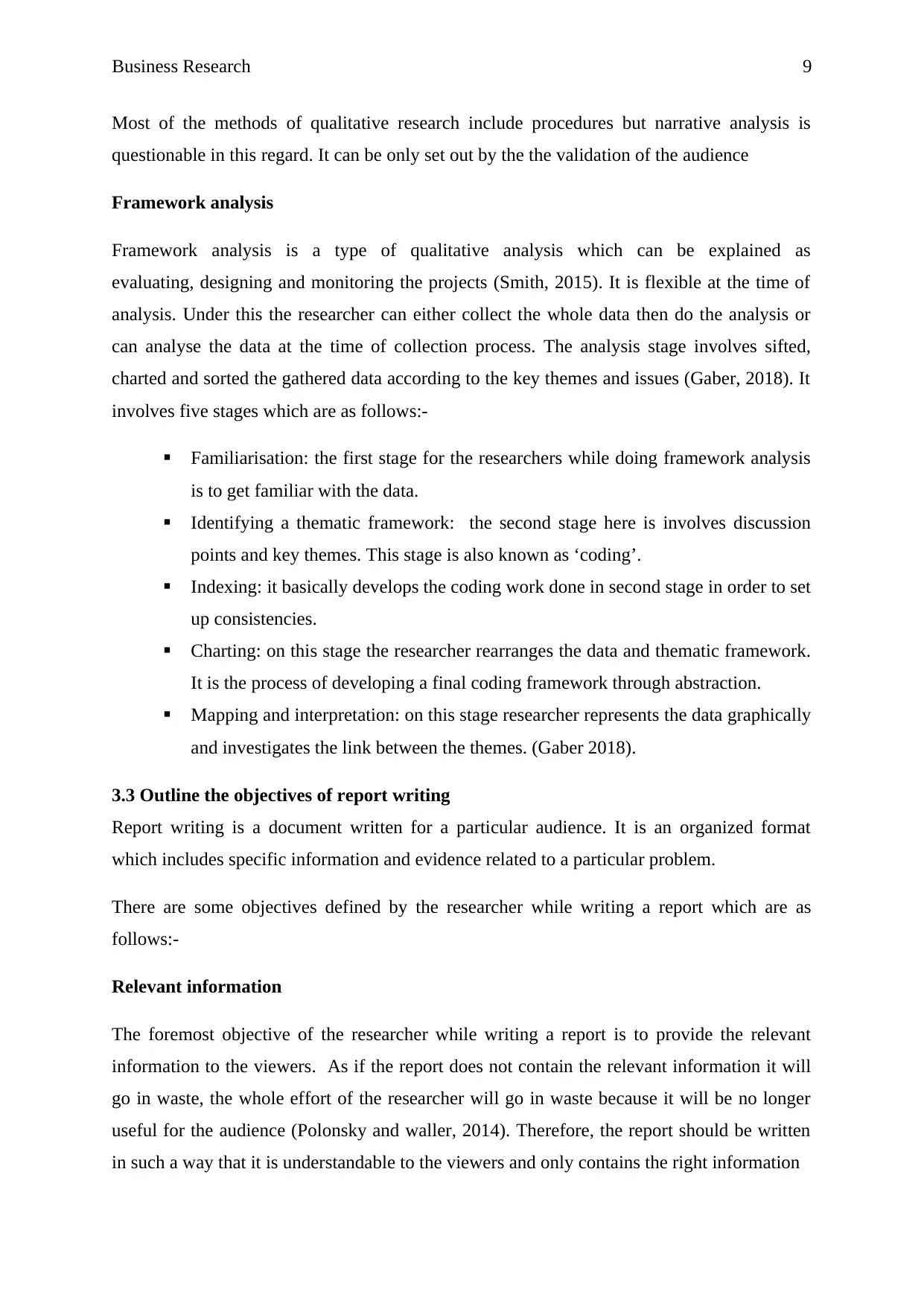
Business Research 9
Most of the methods of qualitative research include procedures but narrative analysis is
questionable in this regard. It can be only set out by the the validation of the audience
Framework analysis
Framework analysis is a type of qualitative analysis which can be explained as
evaluating, designing and monitoring the projects (Smith, 2015). It is flexible at the time of
analysis. Under this the researcher can either collect the whole data then do the analysis or
can analyse the data at the time of collection process. The analysis stage involves sifted,
charted and sorted the gathered data according to the key themes and issues (Gaber, 2018). It
involves five stages which are as follows:-
Familiarisation: the first stage for the researchers while doing framework analysis
is to get familiar with the data.
Identifying a thematic framework: the second stage here is involves discussion
points and key themes. This stage is also known as ‘coding’.
Indexing: it basically develops the coding work done in second stage in order to set
up consistencies.
Charting: on this stage the researcher rearranges the data and thematic framework.
It is the process of developing a final coding framework through abstraction.
Mapping and interpretation: on this stage researcher represents the data graphically
and investigates the link between the themes. (Gaber 2018).
3.3 Outline the objectives of report writing
Report writing is a document written for a particular audience. It is an organized format
which includes specific information and evidence related to a particular problem.
There are some objectives defined by the researcher while writing a report which are as
follows:-
Relevant information
The foremost objective of the researcher while writing a report is to provide the relevant
information to the viewers. As if the report does not contain the relevant information it will
go in waste, the whole effort of the researcher will go in waste because it will be no longer
useful for the audience (Polonsky and waller, 2014). Therefore, the report should be written
in such a way that it is understandable to the viewers and only contains the right information
Most of the methods of qualitative research include procedures but narrative analysis is
questionable in this regard. It can be only set out by the the validation of the audience
Framework analysis
Framework analysis is a type of qualitative analysis which can be explained as
evaluating, designing and monitoring the projects (Smith, 2015). It is flexible at the time of
analysis. Under this the researcher can either collect the whole data then do the analysis or
can analyse the data at the time of collection process. The analysis stage involves sifted,
charted and sorted the gathered data according to the key themes and issues (Gaber, 2018). It
involves five stages which are as follows:-
Familiarisation: the first stage for the researchers while doing framework analysis
is to get familiar with the data.
Identifying a thematic framework: the second stage here is involves discussion
points and key themes. This stage is also known as ‘coding’.
Indexing: it basically develops the coding work done in second stage in order to set
up consistencies.
Charting: on this stage the researcher rearranges the data and thematic framework.
It is the process of developing a final coding framework through abstraction.
Mapping and interpretation: on this stage researcher represents the data graphically
and investigates the link between the themes. (Gaber 2018).
3.3 Outline the objectives of report writing
Report writing is a document written for a particular audience. It is an organized format
which includes specific information and evidence related to a particular problem.
There are some objectives defined by the researcher while writing a report which are as
follows:-
Relevant information
The foremost objective of the researcher while writing a report is to provide the relevant
information to the viewers. As if the report does not contain the relevant information it will
go in waste, the whole effort of the researcher will go in waste because it will be no longer
useful for the audience (Polonsky and waller, 2014). Therefore, the report should be written
in such a way that it is understandable to the viewers and only contains the right information
Paraphrase This Document
Need a fresh take? Get an instant paraphrase of this document with our AI Paraphraser
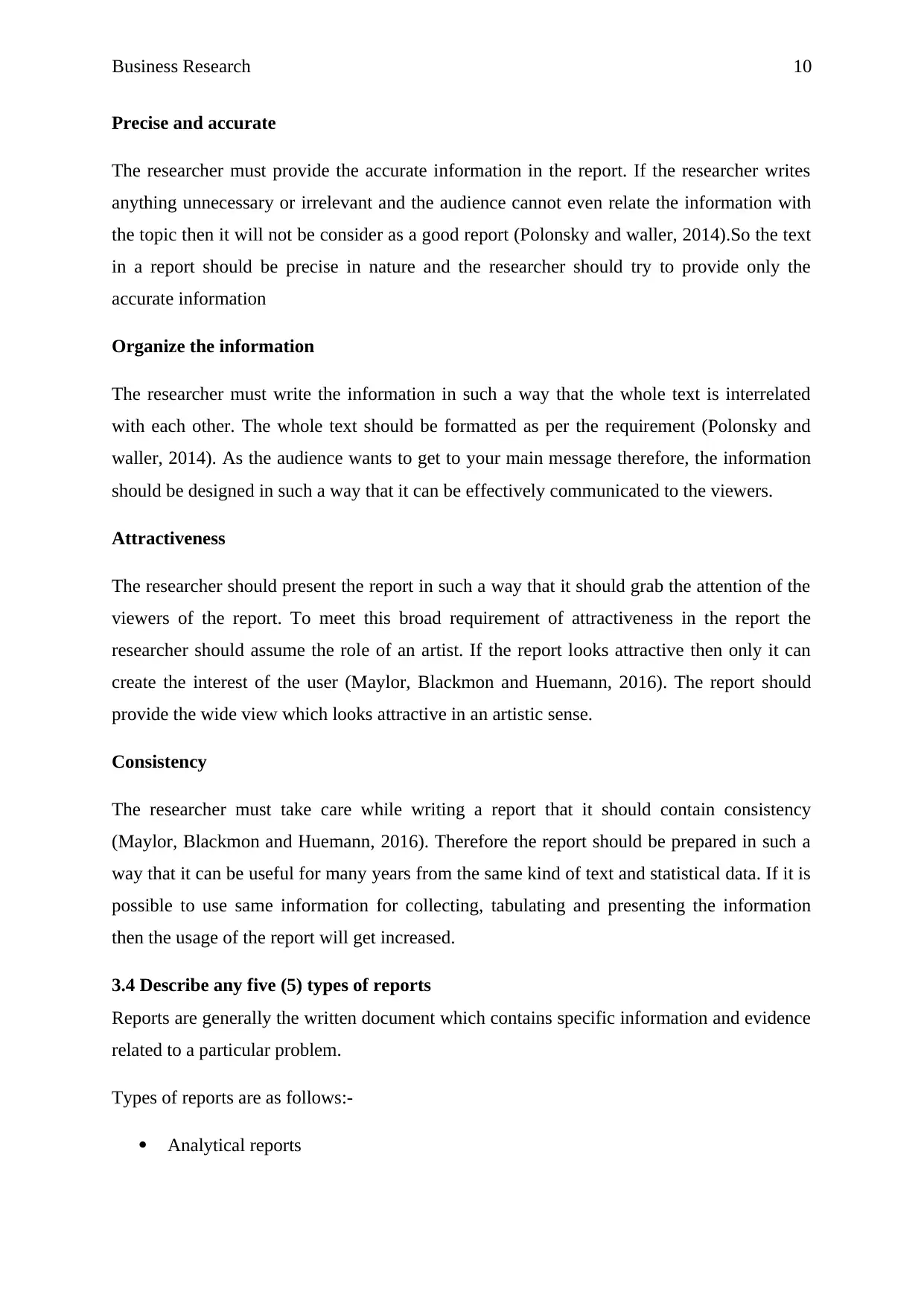
Business Research 10
Precise and accurate
The researcher must provide the accurate information in the report. If the researcher writes
anything unnecessary or irrelevant and the audience cannot even relate the information with
the topic then it will not be consider as a good report (Polonsky and waller, 2014).So the text
in a report should be precise in nature and the researcher should try to provide only the
accurate information
Organize the information
The researcher must write the information in such a way that the whole text is interrelated
with each other. The whole text should be formatted as per the requirement (Polonsky and
waller, 2014). As the audience wants to get to your main message therefore, the information
should be designed in such a way that it can be effectively communicated to the viewers.
Attractiveness
The researcher should present the report in such a way that it should grab the attention of the
viewers of the report. To meet this broad requirement of attractiveness in the report the
researcher should assume the role of an artist. If the report looks attractive then only it can
create the interest of the user (Maylor, Blackmon and Huemann, 2016). The report should
provide the wide view which looks attractive in an artistic sense.
Consistency
The researcher must take care while writing a report that it should contain consistency
(Maylor, Blackmon and Huemann, 2016). Therefore the report should be prepared in such a
way that it can be useful for many years from the same kind of text and statistical data. If it is
possible to use same information for collecting, tabulating and presenting the information
then the usage of the report will get increased.
3.4 Describe any five (5) types of reports
Reports are generally the written document which contains specific information and evidence
related to a particular problem.
Types of reports are as follows:-
Analytical reports
Precise and accurate
The researcher must provide the accurate information in the report. If the researcher writes
anything unnecessary or irrelevant and the audience cannot even relate the information with
the topic then it will not be consider as a good report (Polonsky and waller, 2014).So the text
in a report should be precise in nature and the researcher should try to provide only the
accurate information
Organize the information
The researcher must write the information in such a way that the whole text is interrelated
with each other. The whole text should be formatted as per the requirement (Polonsky and
waller, 2014). As the audience wants to get to your main message therefore, the information
should be designed in such a way that it can be effectively communicated to the viewers.
Attractiveness
The researcher should present the report in such a way that it should grab the attention of the
viewers of the report. To meet this broad requirement of attractiveness in the report the
researcher should assume the role of an artist. If the report looks attractive then only it can
create the interest of the user (Maylor, Blackmon and Huemann, 2016). The report should
provide the wide view which looks attractive in an artistic sense.
Consistency
The researcher must take care while writing a report that it should contain consistency
(Maylor, Blackmon and Huemann, 2016). Therefore the report should be prepared in such a
way that it can be useful for many years from the same kind of text and statistical data. If it is
possible to use same information for collecting, tabulating and presenting the information
then the usage of the report will get increased.
3.4 Describe any five (5) types of reports
Reports are generally the written document which contains specific information and evidence
related to a particular problem.
Types of reports are as follows:-
Analytical reports
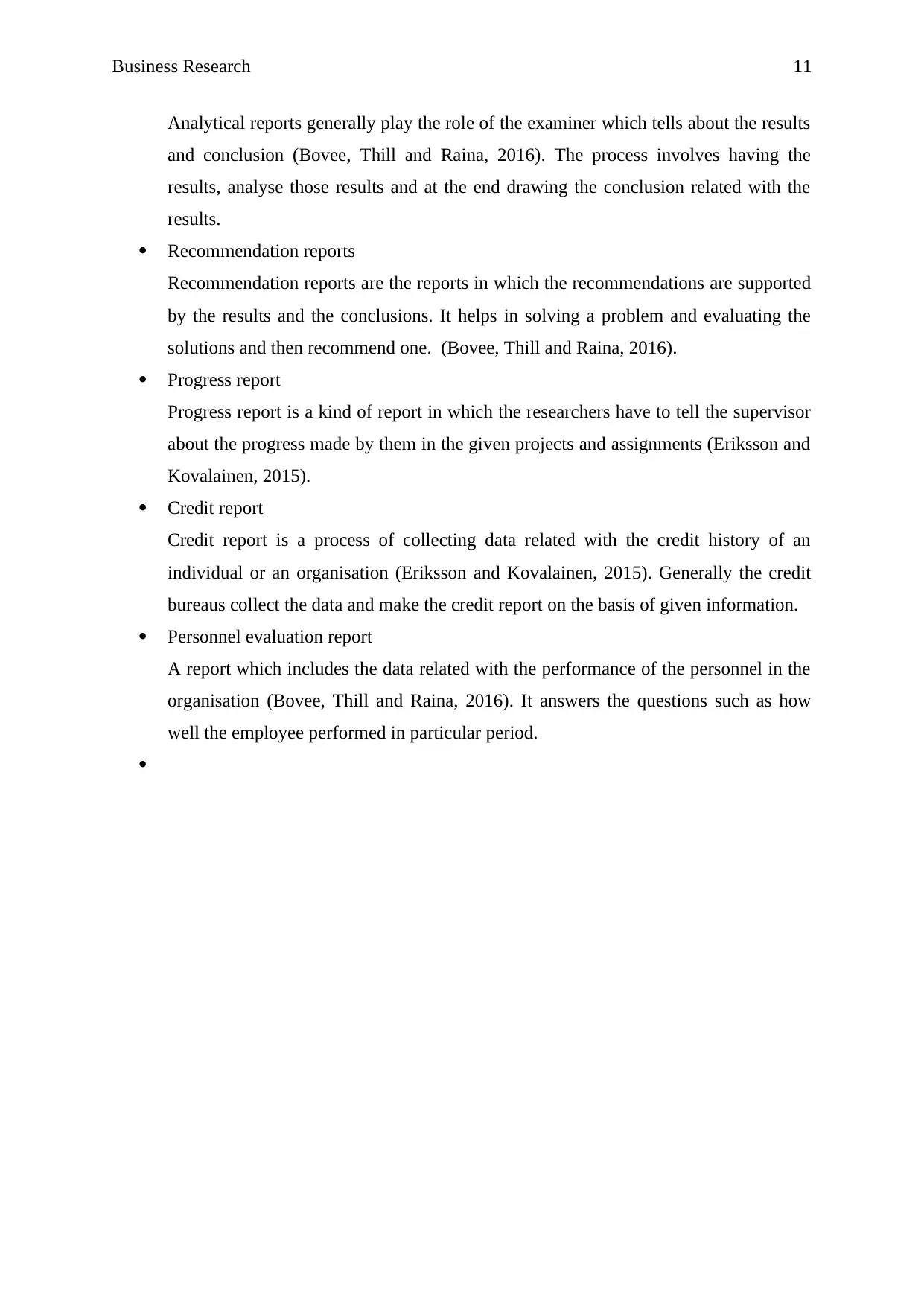
Business Research 11
Analytical reports generally play the role of the examiner which tells about the results
and conclusion (Bovee, Thill and Raina, 2016). The process involves having the
results, analyse those results and at the end drawing the conclusion related with the
results.
Recommendation reports
Recommendation reports are the reports in which the recommendations are supported
by the results and the conclusions. It helps in solving a problem and evaluating the
solutions and then recommend one. (Bovee, Thill and Raina, 2016).
Progress report
Progress report is a kind of report in which the researchers have to tell the supervisor
about the progress made by them in the given projects and assignments (Eriksson and
Kovalainen, 2015).
Credit report
Credit report is a process of collecting data related with the credit history of an
individual or an organisation (Eriksson and Kovalainen, 2015). Generally the credit
bureaus collect the data and make the credit report on the basis of given information.
Personnel evaluation report
A report which includes the data related with the performance of the personnel in the
organisation (Bovee, Thill and Raina, 2016). It answers the questions such as how
well the employee performed in particular period.
Analytical reports generally play the role of the examiner which tells about the results
and conclusion (Bovee, Thill and Raina, 2016). The process involves having the
results, analyse those results and at the end drawing the conclusion related with the
results.
Recommendation reports
Recommendation reports are the reports in which the recommendations are supported
by the results and the conclusions. It helps in solving a problem and evaluating the
solutions and then recommend one. (Bovee, Thill and Raina, 2016).
Progress report
Progress report is a kind of report in which the researchers have to tell the supervisor
about the progress made by them in the given projects and assignments (Eriksson and
Kovalainen, 2015).
Credit report
Credit report is a process of collecting data related with the credit history of an
individual or an organisation (Eriksson and Kovalainen, 2015). Generally the credit
bureaus collect the data and make the credit report on the basis of given information.
Personnel evaluation report
A report which includes the data related with the performance of the personnel in the
organisation (Bovee, Thill and Raina, 2016). It answers the questions such as how
well the employee performed in particular period.
⊘ This is a preview!⊘
Do you want full access?
Subscribe today to unlock all pages.

Trusted by 1+ million students worldwide
1 out of 14
Related Documents
Your All-in-One AI-Powered Toolkit for Academic Success.
+13062052269
info@desklib.com
Available 24*7 on WhatsApp / Email
![[object Object]](/_next/static/media/star-bottom.7253800d.svg)
Unlock your academic potential
Copyright © 2020–2025 A2Z Services. All Rights Reserved. Developed and managed by ZUCOL.





